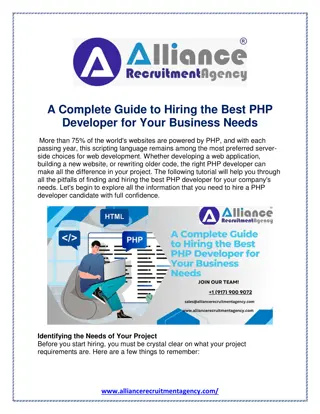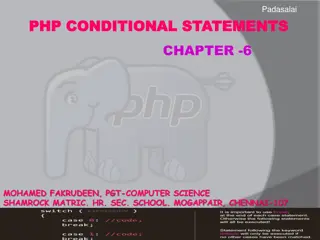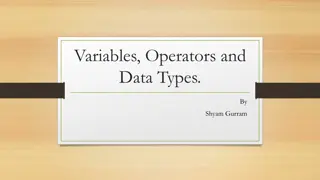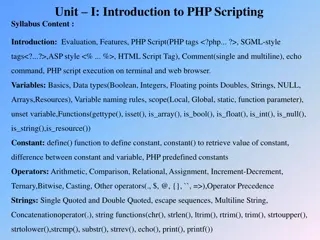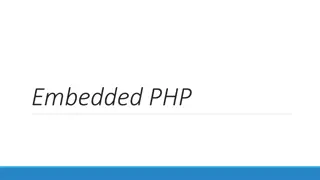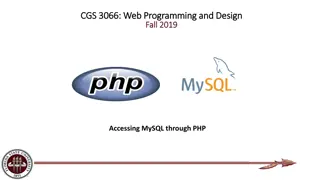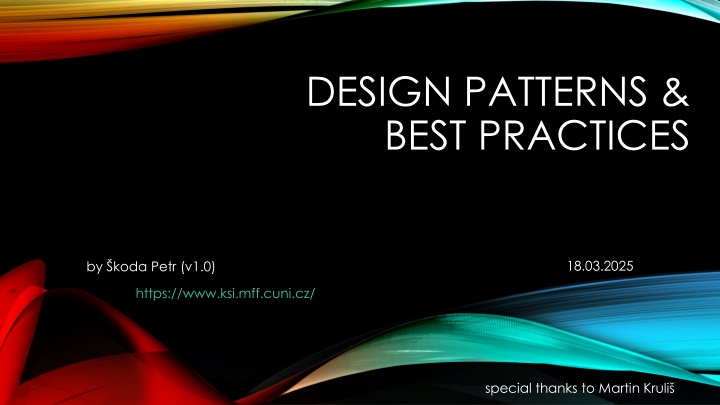
Software Design Patterns and Best Practices
"Explore the impact of design patterns on software quality, learn about front controller design, and discover application development best practices. Enhance your software engineering skills with valuable insights and examples."
Download Presentation

Please find below an Image/Link to download the presentation.
The content on the website is provided AS IS for your information and personal use only. It may not be sold, licensed, or shared on other websites without obtaining consent from the author. If you encounter any issues during the download, it is possible that the publisher has removed the file from their server.
You are allowed to download the files provided on this website for personal or commercial use, subject to the condition that they are used lawfully. All files are the property of their respective owners.
The content on the website is provided AS IS for your information and personal use only. It may not be sold, licensed, or shared on other websites without obtaining consent from the author.
E N D
Presentation Transcript
DESIGN PATTERNS & BEST PRACTICES 18.03.2025 by koda Petr (v1.0) https://www.ksi.mff.cuni.cz/ special thanks to Martin Kruli
2 APPLICATION DEVELOPMENT SOFTWARE ENGINEERING APPROACH Analysis Gathering/anticipating user requirements Pay extra attention to scaling problems Development Use appropriate scope Trivial custom PHP for trivial applications, robust frameworks and design patterns for complex applications Testing User/Application Testing (e.g., Selenium) Unit testing (e.g., PHPUnit) Continuous Integration (e.g., Travis CI, GitHub Actions)
3 DESIGN PATTERNS Impact of design patterns on software quality: a systematic literature review Published: 01 February 2020 Design patterns represent solutions to frequently occurring software problems for designing good quality software. 23 design patterns called gang of four (GoF) patterns. GoF design patterns are classified into three categories: structural, creational, and behavioural patterns.
5 APPLICATION DESIGN FRONT CONTROLLER Application has a single point of entry (index.php) All requests are directed to this script (bootstrap) E.g., using mod_rewrite in Apache configuration Bootstrap script ensures routing and dispatching Routing selection of target class (routine, method, ) Dispatching invocation of target (loading script, ) Different handling for GET and POST (PUT, DELETE, ) requests Advantages More secure (only one gate to fortify) Less error-prone for programmers
6 APPLICATION DESIGN FRONT CONTROLLER EXAMPLE Redirecting everything to bootstrap (possibly with some URL rewriting) Apache .htaccess file RewriteEngine On RewriteBase /vyuka/examples/1-12-best/ RewriteCond %{REQUEST_URI} !index\.php RewriteRule ^([-a-zA-Z0-9_]+)(/([-a-zA-Z0-9_]+))?/?$ index.php?%{QUERY_STRING}&page=$1&action=$3 [L] /vyuka/examples/1-12-best/foo/bar is internally rewritten to /vyuka/examples/1-12-best/index.php?page=foo&action=bar
7 APPLICATION DESIGN FRONT CONTROLLER EXAMPLE Bootstrap script index.php foreach (glob("*.php") as $include) { require_once(__DIR__ . "/$include"); // better yet, use autoload } try { $config = require _DIR__ . '/config/config.ini.php'; $container = new Container(); $container->init($config); $router = $container->getByName('Router'); $router->dispatch(); } catch (Exception $e) { ... }
8 FRONT CONTROLLER IMPERATIVE VS DECLARATIVE APPROACH Imperative ~ sequence of commands Declarative ~ data definitions - often preferred Can be optimized further with classes and annotations switch ($_GET['page']) { case 'home': require 'home.php'; break; case 'settings': require 'settings.php'; break; ... } $pages = [ 'home' => 'home.php', 'settings' => 'settings.php', ... ]; $page = $_GET['page']; if (isset($pages[$page])) { require $pages[$page]; }
9 FRONT CONTROLLER ROUTING AND DISPATCHING Software design pattern that provides centralized entry point for all request (commands) URL (query) parameters determine actual script/class/method/ Method/function Initializing the libraries, setting up the container Action Controller/Presenter HTTP Front Controller (index.php) Class/file/module Action Controller/Presenter Routing and dispatching
10 APPLICATION DESIGN FRONT CONTROLLER EXAMPLE class Router { public function dispatch() { $page = empty($_GET['page']) ? $this->default : trim($_GET['page']); $controller = $this->container->getByName($page . 'Controller'); if (!$controller) throw new Exception("Unknown page '$page'."); $reqMethod = strtolower($_SERVER['REQUEST_METHOD']); $action = empty($_GET['action']) ? '' : ucfirst(strtolower(trim($_GET['action']))); $method = $reqMethod . $action . 'Action'; if (!method_exists($controller, $method)) throw new Exception("..."); if ($reqMethod === 'post ) $controller->$method($_POST, $_GET); else $controller->$method($_GET); } } }
12 APPLICATION DESIGN MODEL-VIEW-CONTROLLER A guideline how to divide code and responsibility Basis for many frameworks Model Uniform data API for the application Communicates with DB/file storage/ View Provides user interface (HTML rendering) Controller Process requests (using view and model) Business logic
13 APPLICATION DESIGN MODEL-VIEW-CONTROLLER Presentation Tier Data Tier Business Logic Controller Database View Model Invoking actions Dataflow
14 APPLICATION DESIGN MODEL-VIEW-CONTROLLER View User interface, data presentation Typically, responsible for generating HTML Automatic sanitization of presented data (<,> chars) Translations for multilingual applications Templates Mechanisms that separate HTML coding from application programming Allow implementing View features (mentioned above) in declarative (instead of imperative) manner
15 TEMPLATES Idea of Templates Separate HTML (CSS, ) code from PHP scripts Division of work (HTML coders vs. PHP programmers) Template Systems PHP-based Template is also a PHP script PHP-template only includes data into the HTML Text-based Special tags in HTML {{tag_name}}, <%tag_name%> Typically compiled into PHP-base templates
16 VIEWS LATTE TEMPLATES EXAMPLE The same text will appear in the title of the page <h1 n:block=title>Latte Example</h1> If and foreach are translated in PHP structures <ul n:if="$items"> <li n:foreach="$items as $item">{$item|capitalize}</li> </ul> Alternative syntax for if statement Value filtering {if ($user)} <h2>User {$user->login}</h2> Name: {$user->name} Home page: <a n:href="$user->homepage">{$user->homepage}</a> {/if} Context-aware escaping
17 APPLICATION DESIGN MODEL-VIEW-CONTROLLER Model Direct SQL writing is inconvenient Better to use some data abstraction layer Object-relational Mapping (ORM) Tables are mapped to classes or singleton objects (called repositories) Rows are mapped to objects (constructed by repositories) The corresponding code (classes) has to be generated from the database schema (or vice versa) In typical case, the schema is generated from code (classes) Allows migration handling ORM framework generate SQL alter table commands by comparing actual state of code and the schema
18 ORM DOCTRINE /** @Entity @Table(name="subjects") **/ class Lecture { /** @Id @Column(type="integer") @GeneratedValue **/ protected $id; /** @Column(type="string") **/ protected $fullname; /** @ManyToOne(targetEntity="User", inversedBy="teach_lectures") **/ protected $teacher; ... public function getDescriptionString() { ... } public function getStudents() { ... } }
19 ORM DOCTRINE EXAMPLE $entityManager = EntityManager::create($conn, $config); $subj = $entityManager->find('Lecture', (int)$id); $subj->setName('Web Applications'); $entityManager->flush(); $subjs = $entityManager->getRepository('Lecture') ->findBy([ 'programme' => 'I2' ]); foreach ($subjs as $subj) { echo $subj->getDescriptionString(); foreach ($subj->getStudents() as $student) { ... } }
20 MODEL IMPLEMENTING DATA MODELS NotORM Keeping classes and DB schema in sync is very tedious in ORM systems Another approach is to use universal object mapping using dynamic features of PHP $users = $db->users() ->select("id, login, name") ->where("active", true) ->order("name"); foreach ($users as $id => $user) echo $user["name"], "\n";
21 APPLICATION DESIGN MODEL-VIEW-CONTROLLER Controller Integrates business (application) logic Issues commands to view and model Process user requests Requests for displaying content (typically GET request) Requests for modifying app. status (typically POST req.) Typically implements other design patterns Front controller, command, Alternative Model-View-Presenter Slightly more advanced form of MVC View is more separated and does not access model directly
22 CONTROLLER/PRESENTER EXAMPLE class EditPresenter extends BasePresenter { ... public function actionShowEditForm(string $id) { $object = $this->model->get($id); if ($object !== null) { $this->view->setArg('id', $id); $this->view->setArg('editedObject', $object); } $this->view->render(); } ... }
24 COMPONENTS COMPONENT-BASED DEVELOPMENT Modern applications use components to promote encapsulation and separation of concerns Component - a software module that provides some functionality through a well- defined interface Typically, a class that implements an interface (in the code terminology) Possibly a fa ade for a small set of classes Component may depend on other components Typically declares a list of (code) interfaces Dependencies must be satisfied by providing components that implement given interfaces (allows some level of modularity)
25 COMPONENTS EXAMPLE Is this OK? Presenters Presenters Page Controllers Mailer Logger Database (ORM, NotORM) Template Renderer User Auth.
26 COMPONENTS COMPONENT MANAGEMENT Creation and interlinking may be tedious Who creates components? When are the components created? Where is the component configuration? How do one component find other components it needs to use? What about different implementations of the same component types ?
27 COMPONENTS CONTAINER DEPENDENCY Controller Requires a Log class Controller { public function action() { $log = ? } } Create on demand $log = new Log(); Multiple instances of log are created! Log is a singleton $log = Log::getInstance(); Implementation bound Log is looked up/created by a registry $log = Registry::get('Log'); Better, yet tedious
28 DEPENDENCY INJECTION Design pattern that implements inversion of control Component is not responsible for seeking its own dependencies Dependencies are injected externally (by the component manager) Declaring required dependencies In configuration, by annotations, using reflection, The problem of cyclic dependencies DB component requires Log component to log errors Log component requires DB component to save messages Central Component Manager Responsible for creating and initializing components
29 DEPENDENCY INJECTION EXAMPLE /** * @component WelcomePage */ class WelcomePageController implements IController { Component naming convention /** @inject IDatabase */ public $db; Annotations (inject by interface) Annotations (inject by name) /** @inject name="NewsService" */ public $news; function __construct(ILog $log) { ... } } Constructor injection (by type hinting)
31 PHP STANDARDIZATION Standardization beyond language specifications Improves cooperation, library designs, Accepted PSR-1, PSR-2, PSR-12 Coding style guidelines PSR-3 Logger interface PSR-4 Autoloading (classes) PSR-7 HTTP message interface Drafts, pending reviews Container interface, PHPDoc standard,
32 CODING STYLE only opening tag (no closing) <?php namespace Vendor\Package; namespace on first row use FooInterface; use BarClass as Bar; class declaration on one row class Foo extends Bar implements FooInterface { final public function sampleMethod($a, $b = null) { if ($a === $b) { bar($a); } elseif ($a > $b) { $foo->bar($a, $b); } } } space between operator and vars class/method block on new line block opening on the same line 4 space indenting
REPRESENTATIONAL STATE TRANSFER (REST)
34 REST API Server API which offers retrieval and manipulation with application resources in a HTTP-compliant way Resources are identified by URIs Operations are performed by HTTP requests REST formal constraints are Client-server model Stateless interface (no client context is cached at server) Cacheable (response defines whether it can be cached) Uniform interface Layered system (proxies, servers may be replicated) Roy T. Fielding , Dissertation, Doctor of Philosophy 2000 : Architectural Styles and the Design of Network-based Software Architectures
35 REST API HTTP request methods reflect desired operations GET retrieve the resource (nullipotent) POST append new sub-entity in the resource PUT insert/replace the resource (idempotent) DELETE remove the resource (idempotent) Example API for photo gallery /gallery collection of all galleries /gallery/kittens - photos in gallery with ID=kittens /gallery/kittens/kitten01 photo kitten01
36 REST API EXAMPLE /gallery/kittens (photos in gallery) /kitten01 (single photo) /gallery (collection of galleries) Get the list of all galleries (JSON) Get the list of photos in the gallery (JSON) GET Get the image (jpeg) Create a new photo in a gallery Not generally used. Perhaps for adding image metadata POST Create a new gallery Replace list of galleries (atypical) Replace entire list of photos in gallery Replace/insert an image (of given ID) PUT Empty the whole application Remove all photos of a gallery DELETE Remove the given image
37 REST API Summer is coming .. NSWI153 / NDBI046 Source: https://martinfowler.com/articles/richardsonMaturityModel.html
39 CURRENT TRENDS SINGLE PAGE APPLICATIONS The application logic runs in the browser Provides more desktop-like user experience HTTP requests are handled asynchronously (and covertly) Traditional browsing is typically discouraged Handled internally by changing DOM dynamically Thin server architecture Data storage, security verifications, via REST API Disadvantages Application boot - loading and initialization time Less stable execution environment (many browser types)
40 CURRENT TRENDS MICRO FRONTENDS SPA -> Frontend Monolith Website or web app as a composition of features Independent teams Distinct area of business A team is cross functional and develops its features end-to-end
41 CURRENT TRENDS BACKEND FOR FRONTEND Mobile application Desktop application Web application Mobile API Desktop API Web API
TAKEAWAY Front Controller pattern Model-View-Controller pattern Component-based Development PHP Standardization REST API





